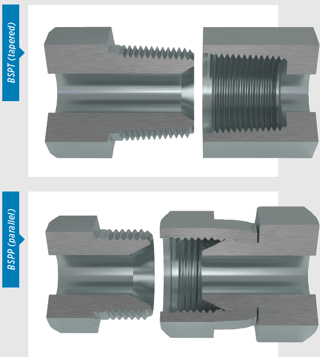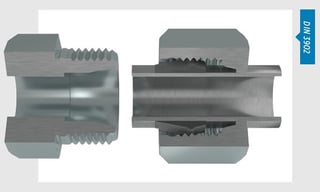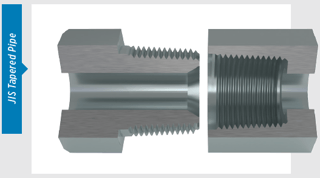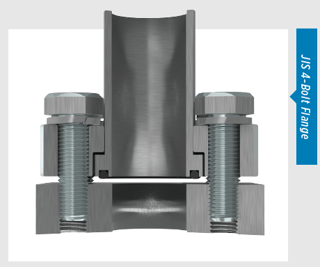There are many different fitting connection types all across the world, this post will help you identify and define UK, German and Japanese connections! This post is an excerpt from our new Thread ID & Measurement Guide.
British Connections
 The two fitting connection types, British Standard Pipe (BSP) and BSPT (tapered) connections, are comparable to NPT fittings, except most sizes have a different thread pitch, plus the O.D.’s and thread form are close, but not the same. Sealing takes place by distortion of the threads. Because of this, British thread sealants are recommended when securing these fitting connection types.
The two fitting connection types, British Standard Pipe (BSP) and BSPT (tapered) connections, are comparable to NPT fittings, except most sizes have a different thread pitch, plus the O.D.’s and thread form are close, but not the same. Sealing takes place by distortion of the threads. Because of this, British thread sealants are recommended when securing these fitting connection types.
BSPP (parallel) male connection is comparable to NPSM male except most sizes have a different thread pitch. A captive seal is made using metal to metal angled surfaces or a combination of metal to metal and an O-ring. This fitting connection type is very similar (but not interchangeable) to the American NPSM male. The female swivel BSPP has a tapered nose flareless swivel where the seal occurs on the cone seat of the male connector.
Note: the thread sizes are often expressed as fractional dimensions preceded by the letters “G” or “R”, where “G” represents a parallel thread and “R” represents a tapered thread. For example, BSPT 5/8-14 can be designated by R 5/8 and BSP 1/16-28 can be designated by G1/16.
German Connections
 DIN 7631 Series is a common metric style connection in hydraulic systems. The male connector has a straight metric thread with a 60° angle on a recessed cone. The female has a straight thread with a seat that is a tapered nose. The contact of the cone of the male and the tapered nose of the female flareless swivel is where the seal takes place. This is also a mechanical connection. DIN 3902 Series is a common male with three different possible female halves. The straight metric thread male has a 24° angle. Its recessed counter-bore matches the tube O.D. it is connected to. The female may be one of the following:
DIN 7631 Series is a common metric style connection in hydraulic systems. The male connector has a straight metric thread with a 60° angle on a recessed cone. The female has a straight thread with a seat that is a tapered nose. The contact of the cone of the male and the tapered nose of the female flareless swivel is where the seal takes place. This is also a mechanical connection. DIN 3902 Series is a common male with three different possible female halves. The straight metric thread male has a 24° angle. Its recessed counter-bore matches the tube O.D. it is connected to. The female may be one of the following:
• A tube, nut and ferrule (compression style, pictured below)
• A tapered nose flareless swivel
• A tapered nose flareless swivel with a DKO style O-ring in the nose.
DIN 3852 – is a male connector and female port. It is a style controlled by German specifications. Other countries sometimes use it as a reference for connector and port designs.
Japanese Connections
 JIS Tapered Pipe (PT) has metric threads per JIS B 0203. These are JIS tapered threads and are comparable to the design of BSPT fitting connections in their dimensions and appearance. JIS tapered thread connections are interchangeable with BSPT connections.
JIS Tapered Pipe (PT) has metric threads per JIS B 0203. These are JIS tapered threads and are comparable to the design of BSPT fitting connections in their dimensions and appearance. JIS tapered thread connections are interchangeable with BSPT connections.
JIS 30° Male Inverted Seat connections are parallel pipe threads per JIS B 0202. JIS parallel connections are comparable to BSPP connections. JIS parallel thread
connections are interchangeable with BSPP connections.
JIS 30° Female (Cone) Seat are parallel pipe threads per JIS B 0202. Japanese JIS 30° flare connections are comparable to American SAE 37° flare connections in an application and sealing principles. Yet, JIS 30° flare angle and dimensions are different, with threads that are similar to BSPP.
JIS B 8363 4-Bolt Flange connections are frequently used in fluid power systems. There are two pressure ratings for JIS B 8363 4-Bolt Flange fittings:
1) Type I Code 61 is the standard series 4-Bolt Flange
2) Type II Code 62 is the 6000 PSI series
Each design concept is the same, yet the flanged head diameters and bolt hole spacing are larger for the Type II 6000 PSI connection. Metric and inch bolts are each used with these connectors. The male connector has a flanged head with a groove for seating an O-ring and either a captive flange or split flange with bolt holes to correspond to the port. The female part of the fitting is a smooth, un-threaded port with four bolt holes set in a rectangular pattern around the port. The seal is made where the O-ring is compressed between the flanged head and the flat surface of the port. The connection is held by threaded bolts.
 JIS 210 Kgf/cm2 4-Bolt Square Flange incorporates a JIS 4-bolt square flange connection which is comparable to SAE 4-bolt flange connections, with one difference - the flange itself is different and the JIS bolt pattern is square.
JIS 210 Kgf/cm2 4-Bolt Square Flange incorporates a JIS 4-bolt square flange connection which is comparable to SAE 4-bolt flange connections, with one difference - the flange itself is different and the JIS bolt pattern is square.

